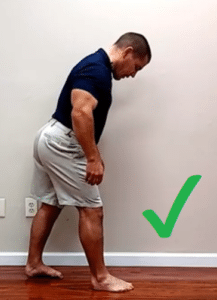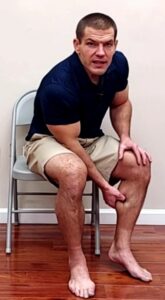How Do You Release Tight Calves?
Tight calves can cause various issues, such as foot, knee, hip, and lower back pain. While stretching is a good starting point, stretching alone may not release very tight calf muscles.
Watch this video to learn 5 mistakes that can cause persistent calf stiffness, plus solutions to help release tight calves.
Table of Contents
- What Causes Tight Calves?
- Mistake 1: Tight Calves From Improper Shoewear
- Mistake 2: Neglecting the Soleus
- Mistake 3: Calf Stretching Technique Errors
- Mistake 4: Tight Calves From Neglecting The Tibialis Anterior
- Mistake 5: Neglecting Myofascial Work
- Conclusion
What Causes Tight Calves?
There are several different factors that can cause tight calves. Below I'll list several common mistakes that lead to calf stiffness, plus some ways to correct them.
Mistake 1: Tight Calves From Improper Shoewear
The first mistake revolves around footwear.
Improper arch support can lead to excessive pronation, or flattening of your foot when you walk.
When you overpronate, you don't stretch your calves fully with each step, which can lead to calf stiffness.
Strengthening your foot arch muscles can help prevent overpronation.
Additionally, wearing shoes with good arch support and/or wearing orthotics can help
Superfeet All-Purpose Support High Arch ...
$54.95 (as of July 26, 2024 18:26 GMT -05:00 - More infoProduct prices and availability are accurate as of the date/time indicated and are subject to change. Any price and availability information displayed on [relevant Amazon Site(s), as applicable] at the time of purchase will apply to the purchase of this product.)However, there's another issue related to shoewear that can cause tight calves.
And that's that we wear shoes all the time.
The heel of most shoes is higher than the toes.
That can cause your calves to become stiff, especially in high-heel shoes.
To counteract that, consider switching to lower-heeled or zero-drop shoes.
ALTRA Men's Torin 7 Road Running Shoe Bl...
27% OffMistake 2: Neglecting the Soleus
The second mistake causing calf stiffness involves neglecting the soleus muscle.
You have 2 calf muscles:
- Gastrocnemius - the more superficial calf muscle that crosses the knee
- Soleus - a deeper calf muscles that doesn't cross the knee
The gastrocnemius has more fast-twitch muscle fibers than the soleus. Therefore, it's used in explosive movement like running and jumping, as well as pushing off when walking.
The soleus has more slow-twitch muscle fibers which are active during sustained postural activities such as standing.
However, because the gastrocnemius muscles are more visible, people often neglect to stretch their soleus muscles.
Knee to Wall Test for a Tight Soleus
You can test the flexibility of your soleus muscles by putting your toe against the wall and then seeing if you can touch your knee to the wall.
If you can do that, move your knee back an inch. If you can touch there, move back an inch again.
Keep moving your foot back until you can no longer touch your knee to the wall while keeping your heel flat.
The normal knee to wall test is measure is that the toes can move 4 inches (10 cm) away from the wall while still allowing the knee to touch.
You can perform the test as an exercise holding 1-2 minutes at endrange in order to stretch a tight soleus.
Mistake 3: Calf Stretching Technique Errors
Moving on to the third mistake, people often make errors in stretching the gastrocnemus.
If you allow your foot to overpronate when stretching, the stretch is not as effective. Therefore, it won't help your calf stiffness.
So don't let your foot overpronate when stretching your calves.
Instead, keep your arch domed and toes pointed straight ahead.
Again, hold this stretch1-2 minutes.
Mistake 4: Tight Calves From Neglecting The Tibialis Anterior
The fourth mistake involves neglecting the tibialis anterior, a muscle on the shin that opposes the calf muscles.
Strengthening this muscle can prevent muscle imbalances that can lead to calf stiffness.
To strengthen your tibialis anterior, you can alternate raising up on your toes and holding for 10 seconds. Then go back down on your heels and raise your toes up for 10 seconds as shown in the video below
Exercises like heel raises followed by toe raises activate both the calf and tibialis anterior, fostering overall lower leg strength.
Mistake 5: Neglecting Myofascial Work
Lastly, overlooking myofascial work can contribute to calf stiffness.
Fascia, the envelope surrounding muscles, may become stiff, limiting muscle flexibility.
There are several ways that you can release stiff fascia in the calves.
Massaging Tight Calves Using A Muscle Massage Stick
You can roll your calves using a muscle massage stick.
Idson Muscle Roller Stick for Athletes- ...
$9.15 (as of July 26, 2024 17:22 GMT -05:00 - More infoProduct prices and availability are accurate as of the date/time indicated and are subject to change. Any price and availability information displayed on [relevant Amazon Site(s), as applicable] at the time of purchase will apply to the purchase of this product.)Roll up and down in the back, inside, and outside of your calves.
Massaging Tight Calves Using A Massage Gun
You can also a massage gun to get your calf muscles to relax.
Auto Amazon Links: No products found. (1 items filtered out)
A bigger head as shown below is good for more of a general massage.
Or, you can get a little bit more specific by using a smaller head. A smaller head provides a little bit more pinpoint treatment to individual knots or trigger points.
Manual Trigger Point Release For Tight Calves
If you want to get a little bit more specific yet, you can do manual trigger point therapy use your hands.
When you're using a massage gun, you get one-way feedback.
You can feel the sore area in your calves, but you can't feel very well through the gun.
If you want to get two-way perception, using your fingers allow you to feel the stiff areas in the calves better.
Use your fingers to find an area in your calves there's a knot or a taut band.
Once you find the tight area, apply a gentle pressure and hold for 1-2 minutes to get your calves to release.
Dry Needling To Release Tight Calf Muscles
If you want to get a little bit more specific, you can go to a physical therapist and get a treatment called dry needling, where your therapist puts an acupuncture needle inside the muscle knot in your calves.
However, although dry needling uses acupuncture needles, it's quite different from acupuncture.
You can learn more about dry needling in the guide below.

Conclusion
So those were 5 common mistakes that can cause tight calves, plus some remedies that you can use to reduce calf stiffness.
Again those were:
Need More Help Tight Calves?
If you live in the St. Louis area and need help for tight calves, we'd be happy to help you here at More 4 Life.
Just tap the button below to request an appointment with one of our specialist physical therapists.















